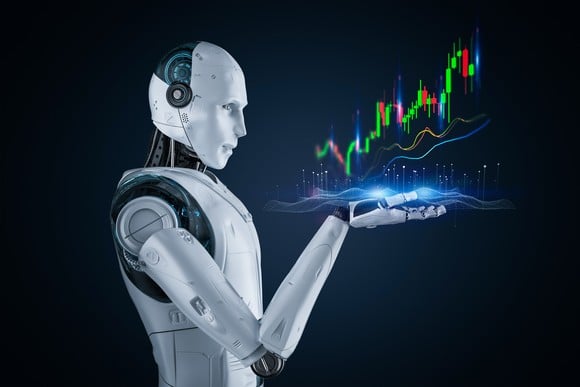November was a big month for Wall Street. The heart of earnings season, Election Day, and key economic reports (jobs and inflation data), set the tone that lifted the Dow Jones Industrial Average, S&P 500, and Nasdaq Composite to respective record highs.
But investors might have missed what can be described as the most important data release of the fourth quarter. Nov. 14 was the deadline for institutional investors with at least $100 million in assets under management (AUM) to file Form 13F with the Securities and Exchange Commission. A 13F allows everyday investors to track which stocks Wall Street's most-successful asset managers have been buying and selling.

Image source: Getty Images.
The latest round of 13Fs should be of particular interest to investors putting their money to work in the artificial intelligence (AI) revolution. According to Sizing the Prize, the analysts at PwC believe AI will increase global gross domestic product by 26% come 2030.
However, the outlook for the face of the AI revolution, semiconductor colossus Nvidia (NVDA 3.78%), is mixed among some of Wall Street's most-prominent billionaire money managers. Whereas Coatue Management's Philippe Laffont can't stop selling shares of Nvidia, Viking Global Investors' Ole Andreas Halvorsen has been an avid buyer.
Halvorsen's Viking Global gobbles up more than 2.26 million shares of Nvidia
When the curtain closed on Sept. 30, Halvorsen was overseeing more than $27 billion in AUM spread across 83 stocks at Viking Global. Since this year began, 2,265,322 shares of Nvidia have been purchased, which is a figure that accounts for the latter's historic 10-for-1 stock split in June.
The reason Viking Global's brightest minds, including Halvorsen, can't stop buying shares of Nvidia can be boiled down to market share dominance, innovation, and software integration.

NASDAQ: NVDA
Key Data Points
According to a study by the analysts at TechInsights, Nvidia accounted for roughly 98% of the graphics processing units (GPUs) shipped to data centers in 2022 and 2023. Even with new GPU competition entering the arena, Nvidia is unlikely to cede much of its monopoly like share.
To add to this point, demand for Nvidia's hardware has handily outpaced supply. When the demand for a good outstrips supply, its price will climb until demand tapers. Nvidia has been enjoying a 100% to 300% price premium for its ultra-popular Hopper (H100) GPU, when compared to the price point of Advanced Micro Devices Insight MI300X chips. This otherworldly price premium has sent Nvidia's gross margin through the roof.
Halvorsen and his team are likely also looking for Nvidia to retain its innovative dominance in the AI space. The successor Blackwell GPU architecture is aimed at accelerating computing capabilities in six areas, including generative AI solutions. Most importantly, it can increase computing speed while being more energy efficient. Nvidia's CEO Jensen Huang characterized demand for Blackwell as "insane" back in October.
Lastly, Halvorsen is likely impressed by Nvidia's integration of its CUDA software platform to keep clients loyal to the brand. CUDA is the toolkit developers use to build large language models and maximize the computing potential of their Nvidia GPUs.

Image source: Getty Images.
Laffont's Coatue jettisoned almost 39.7 million shares of Wall Street's AI darling
Despite Nvidia's phenomenal growth rate, not all billionaire investors are buyers. Over a six-quarter stretch (March 31, 2023 through Sept. 30, 2024), Coatue Management's Philippe Laffont, who coincidentally also oversees close to $27 billion in AUM, sent approximately 39.66 million split-adjusted shares of Nvidia to the chopping block, representing 80% of his fund's stake.
There's little doubt that benign profit-taking has played at least some role in this persistent selling activity. Shares are up 875% since 2023 began, which is a hefty enough gain to encourage most billionaire money managers to cash in some of their chips.
The concern is that there may be more to this selling than just simple profit-taking.
For instance, history doesn't bode particularly well for Nvidia. We haven't witnessed a game-changing technology or innovation escape an early stage bubble-bursting event in three decades. All innovations need proper time to mature, and artificial intelligence doesn't look to be anywhere close to a mature technology, as evidenced by most businesses lacking a clear plan to monetize their AI investments. No stock would be more directly clobbered if the AI bubble bursts than Nvidia.
Insiders have been dumping shares with regularity since Nvidia split its stock in June. NVDA Shares Owned By Insiders data by YCharts.
Coatue's chief might also be taking his cues from Nvidia's insiders, who haven't purchased a single share of their company's stock on the open market in four years. Though not all insider selling activity is necessarily bad news, the only reason insiders buy is if they believe the share price will head higher. Four years without any buying activity paints a clear picture that insiders don't believe their stock is a good value.
There are regulatory worries, too, with the Joe Biden administration restricting exports of AI chips and related equipment to China. With the incoming Donald Trump administration looking to play hardball with the world's No. 2 economy by implementing tariffs, it doesn't appear as if Nvidia's situation will improve.
Laffont may be honing in on increasing competition for Nvidia, as well. In addition to AMD ramping up production, many of Nvidia's top customers by net sales (i.e., members of the "Magnificent Seven") are developing AI chips of their own. Even with these chips lagging Nvidia's Hopper and Blackwell GPUs in computing speed, they're going to be considerably cheaper and more accessible. In short, Nvidia could lose out on valuable data center space.
While Nvidia's eye-popping growth rate has done the talking over the last two years, it's difficult to envision the company bucking three decades of history or avoiding margin contraction as competition picks up and AI-GPU scarcity wanes.
